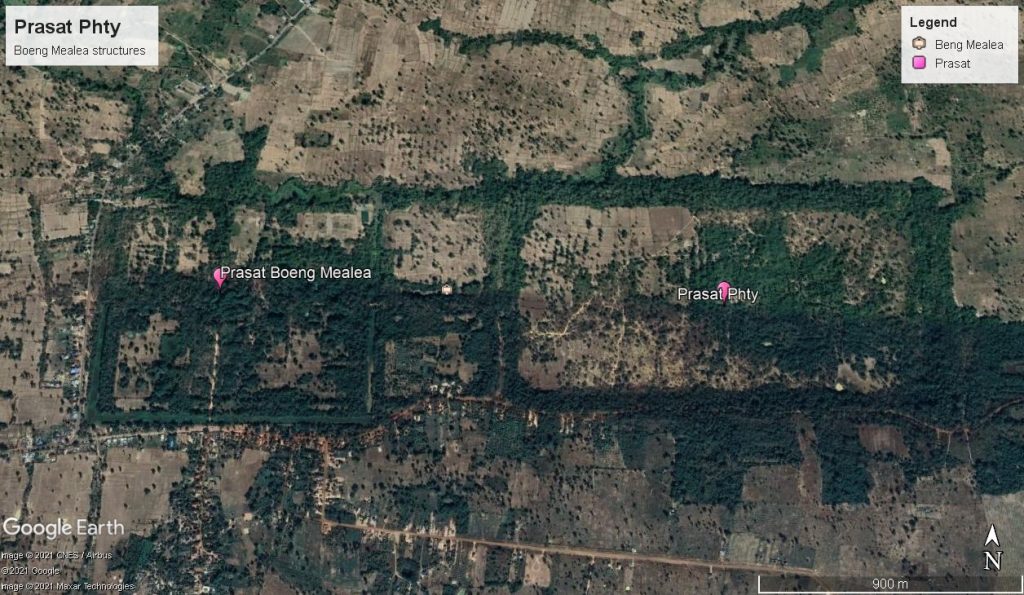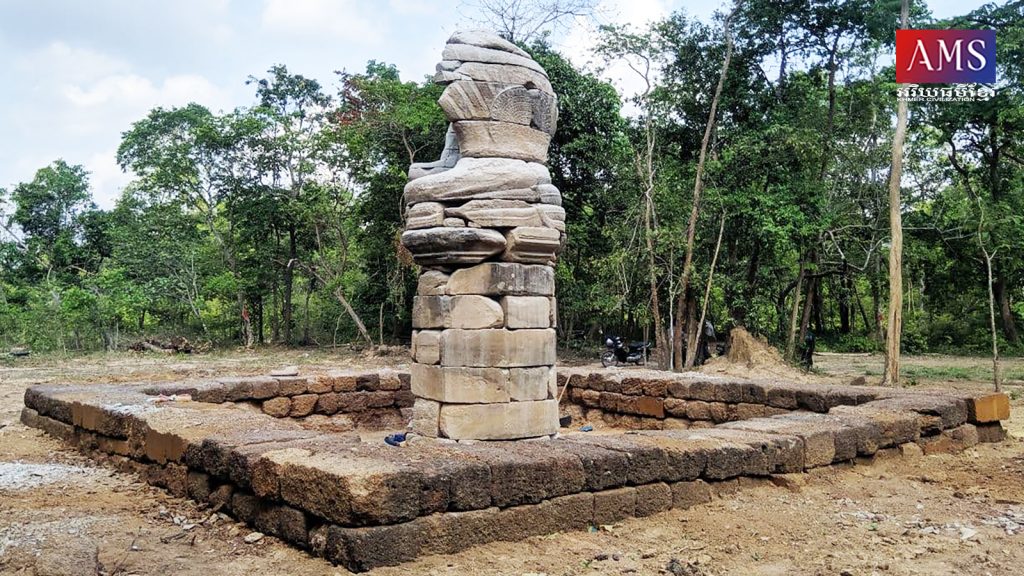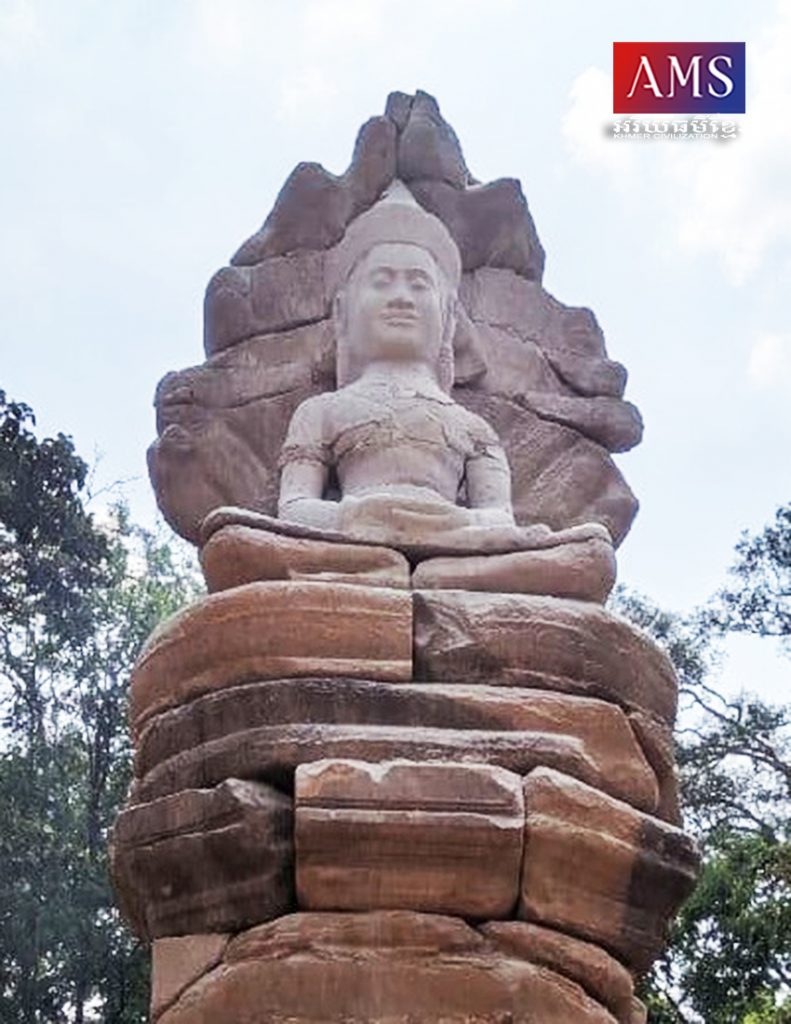ប្រាសាទផ្ទី មានទីតាំងស្ថិតនៅចំពាក់កណ្តាលបឹងមួយនៅមុខខាងកើតប្រាសាទបឹងមាលា ចម្ងាយប្រមាណ ១៣០០ម៉ែត្រពីកសិន្ធុប្រាសាទបឹងមាលា ត្រង់ភូមិបេងមាលា ឃុំបេងមាលា ស្រុកស្វាយលើ ខេត្តសៀមរាប ហើយស្ថិតនៅតាមបណ្តោយផ្លូវបុរាណមួយដែលចេញពីតំបន់អង្គរឆ្ពោះទៅកោះកេរ្តិ៍ (សូមមើលប្លង់លេខ១)។ ឈ្មោះ “ផ្ទី” គឺជាឈ្មោះដែលអ្នកស្រុកហៅសព្វថ្ងៃ ដែលទំនងអ្នកស្រុកហៅសំដៅលើឈ្មោះរុក្ខជាតិមួយប្រភេទដុះនៅទីនោះ ឬគេអាចហៅធៀបសំណង់នោះទៅនឹងអ្វីមួយ។ នៅក្នុងការកត់ត្រារបស់អ្នកស្រាវជ្រាវជនជាតិបារាំង គឺលោក Étienne Aymonier បានហៅឈ្មោះប្រាសាទនេះថា “បល្ល័ង្ក”“(Balang) ហើយលោកបានហៅបឹងខាងមុខនេះថា “រហាល” ឬ “បារាយណ៍” ឬ “វាលផ្ទី” ឬ “វាលមន្ទីរ” (Veal Bati ou Veal Monti)។ ឯលោក Lunet De Lajonquière ទំនងជាចង់កត់ត្រាឈ្មោះថាបល្ល័ង្កដូចគ្នា ប៉ុន្តែអាចលោកច្រឡំកត់ត្រាច្រឡំអក្សរទៅជា “Batang” (មិនច្បាស់ថាត្រូវនឹងខ្មែរថាដូចម្តេច)។
នៅពេលដែលលោកទាំងពីរមកចុះបញ្ជីនិងស្រាវជ្រាវនៅប្រាសាទផ្ទី រូបរាង និងរចនាសម្ព័ន្ធខាងក្នុងរបស់ប្រាសាទបានបាក់បែកអស់ហើយ។ ប៉ុន្តែ លោក Lunet De Lajonquière រៀបរាប់ថា នៅផ្ទៃខាងក្នុងប្រាសាទដែលសាងអំពីថ្មភក់នោះគេតម្រៀបចេញជារាងកាកបាទធំមួយ។ ចំណែក ទីលានធ្វើពីថ្មបាយក្រៀមដែលរៀបនៅជុំវិញលោក Étienne Aymonier បញ្ជាក់ថាមានប្រវែង ១០ម៉ែត្រ និងកម្ពស់ប្រមាណ ០,៨ម៉ែត្រ។ មកដល់ឆ្នាំ២០២១ អ្នកជំនាញនៃអាជ្ញាធរជាតិអប្សរាបានរៀបចំជួសជុលប្រាសាទឲ្យមានទម្រង់ដើមវិញ។ ប្លង់បន្ទាប់ពីតម្រៀបហើយ យើងឃើញថា ប្រាសាទផ្ទី មានលក្ខណៈប្លង់ប្លែកពីប្រាសាទផ្សេងៗនៅទូទាំងប្រទេសកម្ពុជា ពោល គឺមានសំណង់ថ្មបាយក្រៀមជុំវិញប្រវែងប្រមាណ ១០ម៉ែត្រ ដូចជាលានមួយនៅព័ទ្ធជុំវិញសំណង់ខាងក្នុងដែលគេរៀបអំពីថ្មបាយក្រៀមមានស្ទើរមូលខ្ពស់ទៅលើទ្រព្រះពុទ្ធប្រក់នាគមួយអង្គ។ តាមការរៀបរាប់របស់ឯកឧត្តម គឹម សុធិន អគ្គនាយករងនៃអាជ្ញាធរអប្សរា នៅលើបណ្តាញសង្គមហ្វេសបុក ព្រះសិររបស់ព្រះពុទ្ធរូបបានបាត់បង់ទៅហើយ។ ម្ល៉ោះហើយ ក្រុមអ្នកជំនាញបានឆ្លាក់ព្រះសិរថ្មីមកបំពេញជំនួសព្រះសិរចាស់ដែលបាត់បង់។ ប៉ុន្តែ ផ្ទៃរូបនាគមានក្បាលចំនួនប្រាំពីរ និងព្រះកាយរបស់ព្រះពុទ្ធរូបនៅរក្សាថ្មចាស់ដដែល។
សំណង់ដែលមានព្រះពុទ្ធប្រក់នាគនៅចំកណ្តាលបឹងបែបនេះ យើងពុំសូវជួបនោះទេ ពោល គឺយើងច្រើនឃើញជាសំណង់ប្រាសាទធំៗមានតម្កល់ទេពនៅខាងក្នុងដូចប្រាសាទទូទៅ ជាក់ស្តែងដូចជាប្រាសាទមេបុណ្យខាងលិច និងប្រាសាទព្រះថ្កោលជាដើម។ ព្រះពុទ្ធប្រក់នាគ ជារូបភាពមួយដែលគេសាងឡើងដើម្បីរំឮកឬរំលេចឲ្យឃើញពីឈុតមួយដែលព្រះពុទ្ធអង្គយាងគង់តាំងសមាធិនៅក្បែរស្រះមុជ្ជលិន្ទ។ ពាក្យ “មុជ្ជលិន្ទ” សំដៅដល់ឈ្មោះស្រះ និងឈ្មោះសត្វនាគដែលប្រក់ព្រះពុទ្ធអង្គនេះឯង។ មានរឿងមួយដំណាលថា៖ “នៅពេលព្រះពុទ្ធសក្យមុនីតាំងសមាធិអស់កាលប្រាំមួយសប្តាហ៍ ទ្រង់ក៏បានត្រាស់ដឹងក្លាយជាព្រះពុទ្ធ, បន្ទាប់ពីត្រាស់ដឹងមកទ្រង់បានតស៊ូពុះពារជាមួយភ្លៀងព្យុះអសរយៈពេល ៧ ថ្ងៃ ពេលនោះនាគមុជ្ជលិនមានក្បាលប្រាំពីរក៏បានមកបាំងព្រះសិរព្រះពុទ្ធកុំឲ្យទទឹងភ្លៀង។ ក្រោយមកភ្លៀងក៏បានឈប់នៅថ្ងៃទីប្រាំពីរនោះ រីឯនាគបានប្រែក្រឡាជាមនុស្សមកអង្គុយស្តាប់ព្រះធម៌ទេសនាព្រះពុទ្ធដំបូងគេ”។ ជាទូទៅចម្លាក់ព្រះពុទ្ធប្រក់នាគ មានវត្តមាននៅក្នុងសិល្បៈខ្មែរចាប់ពីពាក់កណ្តាលផ្នែកទី២នៃស.វ.ទី១០មក ហើយចាប់ផ្តើមពេញនិយមខ្លាំងមកក្នុងរជ្ជកាលព្រះបាទជ័យវរ្ម័នទី៧រហូតគេចាត់ទុកទៅជាព្រះភៃសជ្យគុរុ (ព្រះពុទ្ធគ្រូថ្នាំ) ដែលយើងតែងឃើញគេឆ្លាក់ព្រះហស្តទ្រង់កាន់ដបថ្នាំ។ ទោះបីយើងមានភស្តុតាងជាចម្លាក់ចាប់ពីរវាងស.វ.ទី១០ ក៏ដោយ ក៏ខ្មែរទំនងគោរពនាគមុជ្ជលិនតាំងពីស.វ.ទី៧មក ដ្បិតយើងធ្លាប់ឃើញមានសិលាចារឹកមួយនៅក្រុមប្រាសាទយាយព័ន្ធ (សំបូរព្រៃគុក) ចុះបញ្ជីលេខ K.607 រៀបរាប់អំពីអំណោយខ្ញុំបម្រើស្រីប្រុសថ្វាយចំពោះទេពមួយអង្គព្រះនាមថា “កម្រតាងអញមុចលិន្ទ”។
បើមើលតាមសិល្បៈព្រះពុទ្ធរូបប្រក់នាគនៅប្រាសាទផ្ទី មានទម្រង់ជាសិល្បៈរចនាបថបាយ័ន្តក្នុងរជ្ជកាលព្រះបាទជ័យវរ្ម័នទី៧ (គ.ស.១១៨១-១២១៨)។ ប៉ុន្តែ យើងមិនដឹងច្បាស់អំពីគោលបំណងថា ហេតុអ្វីសិល្បករសម្រេចយករូបព្រះពុទ្ធប្រក់នាគមកដាក់នៅកណ្តាលបឹងនេះទេ។ ប៉ុន្តែ បើពិនិត្យលើកាយវិការនៃព្រះហស្តរបស់ព្រះពុទ្ធអង្គ យើងឃើញទ្រង់យកបាតព្រះហស្តទាំងពីដាក់ត្រួតផ្ញារលើគ្នាដូចនឹងកាយវិការនៃទេពភៃសជ្យគុរុកាន់ដបថ្នាំដែរ។ បើពិតជាដូច្នោះមែនទំនងគេភ្ជាប់ទឹកបឹងនេះ ជាទឹកពិសិដ្ឋដែលជាភោគផល ឬពរជ័យ អាចព្យាបាលនូវរោគាទាំងឡាយដល់សត្វលោក។ ទោះបីយ៉ាងណាក្តី នេះគ្រាន់តែជាការសនិដ្ឋានបឋមប៉ុណ្ណោះ។ កន្លងមក យើងធ្លាប់ដឹងថាខ្មែរនិយមបញ្ចុះរបស់អ្វីមួយនៅកណ្តាលបឹងឬស្រះណាស់ ដូចករណីស្រះសង់គេបានបញ្ចុះអណ្តើកជាតឹកតាងស្រាប់។
————————————-
Phty temple
Phty temple is located in the middle of a lake in front of Boeng Mealea temple, about 1,300 meters from the center of Boeng Mealea temple, in Beng Mealea village, Beng Mealea commune, Svay Leu District, Siem Reap province, and along an ancient road from Angkor to Koh Ker. The name “Phty” is the name that the locals use today, which probably refers to the name of a plant that grows there or can be compared to construction to something. Mr. Étienne Aymonier called the temple “Throne” (Balang) and he called the lake “Rohal” or “Baray” or “Veal Phty” or ” Veal Bati ou Veal Monti”. Whereas, Mr. Lunet De Lajonquière may have wanted to name the same throne, but may have mistakenly spelled it as“ Batang ”(not sure what the Khmer word is).
Based on the study of Lunet De Lajonquière and Étienne Aymonier described the inside of the sandstone temple as a large cross and the laterite terrace around contained 10 meters long and about 0.8 meters high. During their study, the temple already collapsed. By 2021, experts of the APSARA Authority have restored the temple to its original form. After restoration, we see that the temple is different from other temples throughout Cambodia, that is, a laterite structure of about 10 meters and contained round supporters of the Buddha on Naga statue.
We rarely see structures with a Buddha on Naga in the center of the lake, that is, we often see large temple structures with deities inside temples, for instance, the Western Mebon and Preah Thkol temples, etc. Buddha on Naga is an image built to commemorate or highlight a scene in which the Buddha is meditating near the Muchalinda pond. The word “Muchalinda” refers to the name of the pond and the name of the Naga protected the Buddha. In general, the sculpture of the Buddha on Naga has been present in Khmer art since the second half of the 10th century and became very popular during the reign of Jayavarman VII until it was considered as the Bhaisajyaguru (Buddha Medicine) that we often see carved in his hand holding a bottle of medicine. Although we have evidence of sculptures dating back to the 10th century, the Khmers are likely to worship Naga Muchalinda since the 7th century, as we have seen an inscription on the group of Yeay Poan temples K.607 (Prasat Sambor Prei Kuk) describes the gift of a male and female slave to a deity named “Kamratan An Muchalinda”.
According to the art of the Buddha on Naga statue at the Phty temple. There was an art form in the Bayon style during the reign of Jayavarman VII (1181-1218 AD). But we do not know exactly why the artist decided to install a Buddha on Naga statue in the center of the lake. But if we look at the gestures of the Buddha, we see that he puts his hands on each other upward, just like the gesture of the Bhaisajyaguru god holding a medicine bottle. If so, it is likely that the lake is connected to the sacred water that can cure all diseases to people. However, this is only a preliminary conclusion. In the past, we used to know that Khmer people like to bury something in the center of a lake or a pond, just like in the case of the Srah Srang, they bury a turtle as evidence.
អត្ថបទដើម៖ លោក ម៉ង់ វ៉ាលី










